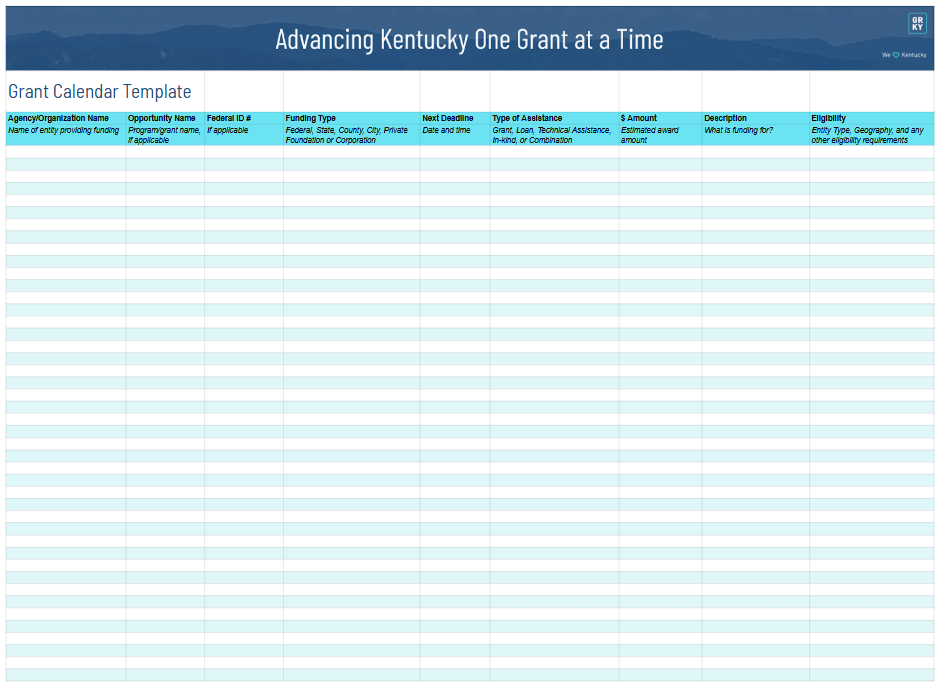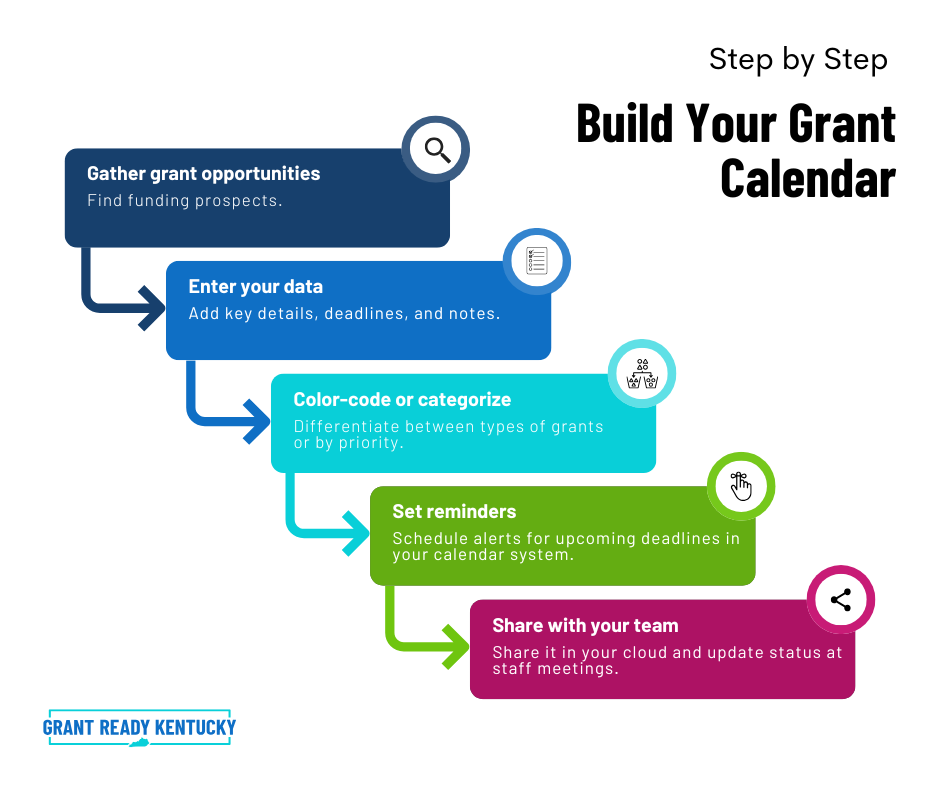Why You Need a Grant Calendar
If you’ve ever discovered a grant deadline at the last minute—or worse, missed one altogether—you’re not alone. Without a clear system for tracking opportunities, it’s easy for deadlines to sneak by or proposals to feel rushed.
That’s where a grant calendar comes in.
A grant calendar is a simple, customizable tool that helps you track upcoming deadlines, organize funder information, and plan ahead for both applications and reporting. It doesn’t require expensive software or a full-time development office, just a little structure and some team coordination.
No matter the size of your organization, a grant calendar can help you stay focused, proactive, and ready for funding opportunities.
What Exactly is a Grant Calendar?
A grant calendar isn’t just a list of deadlines, it’s a planning tool that gives you a bird’s-eye view of your grant strategy. When you keep all your grant-related information in one place, you unlock a few key benefits:
- No more last-minute scrambles: Track applications, reports, and letters of intent in one centralized location.
- Smarter staff planning: Spot deadline clusters in advance and distribute workloads accordingly.
- Stronger relationships with funders: Timely applications and reports build trust and credibility.
- Better strategy: See the big picture—where your funding comes from, where your gaps are, and what’s coming down the road.
Whether you’re applying for three grants a year or thirty, a grant calendar keeps your organization steady and strategic.
What to Include In Your Grant Calendar
The most useful calendars include both logistical details and strategic insights. We recommend tracking the following:
- Funder name and contact info: So you can reach out with questions or updates
- Grant program name: Especially helpful if a funder offers multiple opportunities
- Website or guidelines link: A quick way to double-check eligibility and instructions
- Award range or average grant size: Helps you prioritize opportunities by potential impact
- Deadline(s): Include LOI (Letter of Intent), full application, and report due dates
- Eligibility notes: Such as geographic focus, match requirements, or population served
- Status: Keep track of whether you've applied, been awarded, declined, or if a report is due
- Responsible staff or volunteer: Assign accountability and avoid confusion
- Notes: Include anything from funder preferences to relationship-building tasks
Our Google Sheet template has all of these fields built in and is ready for you to customize.

Choosing the Right Format
You don’t need fancy grant management software to build an effective calendar. Free or low-cost tools work just fine. Here are a few options:
- Spreadsheets (Google Sheets or Excel): Flexible, sortable, and easy to share
- Project management tools (like Trello or Asana): Great for task-based tracking and visualizing workflows
- Calendar apps (Google Calendar or Outlook): Ideal for scheduling alerts and keeping deadlines visible
- Hybrid approach: Use a spreadsheet for detail tracking and sync key dates into a shared calendar
The best format is the one your team will actually use. Start simple, you can always adopt a more robust tool later.
Step-by-Step: Building Your First Grant Calendar

1. Gather grant opportunities
Start by compiling a list of funding opportunities. Even without paid tools, you can find a wide range of grants. Take a look at our Grant Prospecting Series to help you get started.
2. Enter your data
Use the suggested fields above to start populating your calendar. The goal is to create a comprehensive record for each opportunity.
3. Color-code or categorize
Use color to quickly identify federal vs. state, foundation vs. corporate, or high-priority vs. low-priority grants. This visual layer helps you spot patterns at a glance.
4. Set reminders
Create calendar alerts for key dates, ideally 30 days and 7 days before each deadline. Many tools allow for automatic notifications.
5. Share with your team
If your calendar lives in the cloud (like Google Sheets), make sure it’s shared with anyone who supports grant work including staff, board members, and volunteers. Transparency promotes accountability and teamwork.
Keep It Up To Date
A calendar is only useful if it stays current. Set a recurring monthly or quarterly review to:
- Add new opportunities
- Update statuses (applied, awarded, declined)
- Track upcoming reports
- Remove outdated or no-longer-relevant grants
Pro tip: Make your grant calendar a regular part of staff or board meetings. It keeps grantseeking on the radar and shows progress over time.
Ways to Put Your Grant Calendar to Work
Once your calendar is up and running, it becomes not only a tracking tool, but a strategic asset. Here's how to get even more value from it:
- Be a good neighbor: Share opportunities that aren’t a fit for you with other organizations.
- Use it for stewardship: Set reminders to thank funders, share program updates, or attend events.
- Engage your board: Reviewing the calendar with leadership helps them see funding priorities and open new doors.
- Spot funding gaps: Use your calendar to identify dry spells before they become a problem.
- Celebrate milestones: Mark when grants are submitted, awarded, or renewed. Wins deserve recognition!
Final Thoughts
You don’t need a complex system to manage your grants, just a clear process and a calendar that fits your team’s workflow. With our free template and a bit of consistent upkeep, you can stay organized, strategic, and ready for whatever opportunities come next.